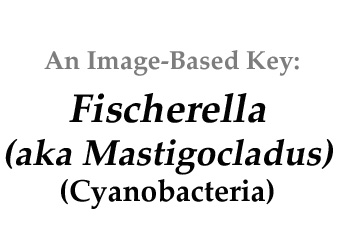|
Home / Cyanobacteria / Filaments / Branched / Fischerella |
||||
|
|
||||
|
|
||||
|
Click on images for larger format |
||||
Name derivation: |
||||
|
Christian Fischer was owner of a porcelain factory in Pirkenhammer (near Karlsbad), Czech Republic, and a friend of Schwabe who published Fischera in 1836 (Linnaea 124) after his name. It’s unclear to me why the publication of Fischerella, clearly derived from Fischera nearly six decades later by Bornet and Flahault is the accepted generic name while Fischerella is now relegated to synonymity. I am indebted to David Hollombe for this history. |
||||
Classification: |
||||
|
Fischerella (Bornet and Flahault) Gomont 1895; 12 of 20 species descriptions are currently accepted taxonomically (Guiry and Guiry 2013). Order Nostocales; Family Hapalosiphonaceae
|
||||
Morphology: |
||||
|
Filaments uniseriate or multiseriate, forming branches by the division of cells perpendicularly to the main filament axis (true branching). |
||||
Similar genera: |
||||
|
Difficult to distinguish from Stigonema, another true-branched cyanobacterium that occupies the same habitats, however Stigonema forms branches that may be multiseriate, while Fischerella's branches that are mainly uniseriate. |
||||
Toxins: |
||||
Toxins: |
||||
Microcystin was produced by Fischerella sp. collected from a freshwater spring in Piracicaba Sao Păulo State, Brazil (Fiore et al. 2009).Microcystin was also produced by Fischerella sp. NQAIF311 from streams and a hot spring in Queensland, Australia; twice as much (> 40 μg g-1 dry weight) when grown in medium without nitrogen, and mainly MC-LR (Cires et al. 2014). |
||||
Habitat: |
||||
|
Mostly found on moist rocks and in moist soil. Some species are also aquatic, epiphytic on submerged objects such as wood or lake macrophytes, or entangled in algae. It also is the primary symbiont of certain lichens. Also found in hot springs in Algeria (Amarouche-Yala et al. 2014) and India (Roy et al. 2014). |
||||
References: |
||||
|
Amarouche-Yala, A. Benouadah, A. el O. Bentabet and P. López-Garciá 2014. Morphological and phylogenetic diversity of thermophilic cyanobacteria in Algerian hot springs. Extremophiles 18:1035-1047. Cires, S., C. Alvarez-Roa, S.A. Wood, J. Puddick, V. Loza and K. Heimann 2013. First report of microcystin-producing Fischerella sp. (Stigonematales, cyanobacteria) in tropical Australia. Toxicon 88:62-66. Fiore, M.F., D.B. Genuártio, C.S.P. da Silva, T.K. Shishido, L.A. B. Moraes, R.C. Neto and M.E. Silva-Stenico 2009. Microcystin production by a freshwater spring cyanobacterium of the genus Fischerella. Toxicon 53:754-761. Gomont, M.[A]. 1895. Note sur le Scytonema ambiguum Kützing. Journal de Botanique 9: 49-52. Graham, L. and L. Wilcox. 2000. Algae. Prentice-Hall Guiry, M.D. and G.M. Guiry 2013. AlgaeBase. World-wide electronic publication, National University of Ireland, Galway. http://www.algaebase.org; searched on 28 February 2013. Roy, S., S. Bhattacharya, M. Debnath and S. Ray 2014. Diversity of cyanobacterial flora of Bakreswar geothermal spring, West Bengal India-II. Algological Studies, prepub, E. Schweizerbart’sche Verlagsbuchhandlung, Stuttgart, Germany |
||||







